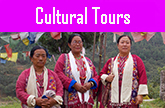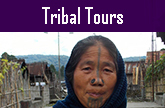North East India Fairs and Festivals
North-East India is the land of hundreds of tribes and communities. It serves as a cultural museum to the nation. Unity in diversity is the main feature in the lives among different tribes and communities of Indian people. Fairs and festivals in North East India showcase rich and vibrant tradition of Indian culture and religious practices. These festivals follow Indian astronomical calendar based on solar and lunar cycles. Hence the dates are subject to change every year.
Assam
Bihu
Bihu is the national festival of Assam. It is the most popular festival among masses rejoiced with merriment and joy irrespective of caste, religion, languages etc. Bihu is basically an agriculture based festival. There are three bihus observed in a year. The most vibrant bihu among three bihus is Rongali Bihu or Bohag Bihu celebrated during spring season from 13th April for a week. At the arrival of the spring season when Mother Nature appears in her splendid outlook with unparallel beauty and bounty, Assamese community celebrates Rongali Bihu with traditional joviality and passion. Nowadays, it has become a major urban festival observed with competitive performance of folk songs, solo folk dances, group folk dances, drum playing etc throughout the month. The tribal communities of Assam celebrate Rongali Bihu in their own distinctive traditional style. The same festival is observed by Bodo-Kacharis as ‘Baisagu’, Tiwas as ‘Bisu’, Deories as ‘Bahagiyo Bihu’, Rabhas as ‘Nababarsa’, Karbis as ‘Johang Pula’ and Tai Phakes as ‘Pani Bihu’.
Kongali Bihu or Kati Bihu is celebrated during the middle of October when there is deficiency of food articles. Earthen lamps are lighted near Tulsi (Black Basil) plants and in the farming fields and prayer are offered by people for a good harvest season.
Bhogali Bihu or Magh Bihu is celebrated during 13th January and lasts for two days after the annual harvesting season. It is a festival of community feast and bonfire offering prayer to the God of Fire. In some parts of Assam, buffalo fight, cock fight, egg fight, wrestling and other games and sports are held every year. Some unique delicious food items like Chira, Pitha, Akhoi, Doi etc are offered to guests during all bihus.
If interested, please click here >> Book My Festival Tour
Ali–Aai-Ligang
Ali-Aai-Ligang, literally meaning as ‘root–fruit-sow’, is a religious harvest festival celebrated mainly by the Mishing tribal community of Assam. The festival is observed for five days towards the end of February or beginning of March. Mishing people take part in community feast in which fish is an essential food item. Certain activities like fishing, ploughing, cutting trees, burning weeds are sternly practiced. ‘Gumarag’ dance is a popular dance form performed by Missing youths during festive season.
Raas Mahotsav
Raas festival is celebrated with much devotion every year during the month of November in various parts of Assam. Raas festival is observed rejoicing the holiness of Hindu God Lord Krishna and portrayal of his mortal life. The celebration of Raas Mahotsav in Majuli, world’s biggest river island showcases rich tradition of glorious cultural history of Assam. Raas Mahotsav starts from the day of Raas Purnima and is observed for four days. The satras (monasteries) of Majuli carrying a cultural heritage of neo-vaishnavism for more than five hundred years organize religious play shows, performances of folk dances & religious songs, puppet shows, mask culture etc. depicting the holy life of Lord Krishna. Artists of all age groups from different communities of Majuli take active part in celebration of Raas Mahotsav with great enthusiasm.
If interested, please click here >> Book My Festival Tour
Doljatra
Doljatra in Assam is popularly known as ‘Holi’, the festival of colours in other parts of India. It is a religious and seasonal festival celebrated for two days every year during spring season in the middle of March. In Assam, Doljatra, also known as ‘Fakuwa’ & ‘Basant Utsav’ is observed one day prior to Holi festival of mainland India. Introduced first time in Assam by the great Vaishnavite saint Srimanta Shankardeva, Doljatra is nowadays widely observed with great enthusiasm in all Bishnu temples and Satras (monasteries) of Assam. Doljatra is the main festival of Barpeta Satra in which thousands of devotees take part in religious activities performed by the priests. Special songs known as ‘holi songs’ are sung at doljatra festival. Huts made of clay are burnt in Barpeta and in some parts of lower Assam which signify the legends of Holika.
Ambubachi Fair
Ambubachi festival is a religious festival observed for four days during the month of June every year. At the time of Ambubachi all the religious activities are strictly prohibited since it is considered as the annual period of Mother-Earth. Ambubachi fair is organized with much devotion and honour at the famous shakti cult Kamakhya Temple in Guwahati. The main door of the temple remains closed to the visitors. On the fourth day of Ambubachi, the main door gets open to all after the priests perform some essential rituals. Thousands of devotees across India visit Kamakhya temple during Ambubachi fair every year. A glimpse of Kamakhya temple during Ambubachi fair is a lifetime experience worth watching.
Shivaratri Fair
Shivaratri fair is another widely celebrated religious festival of Assam. It is a festival of Shaivities being observed from Ahom era. Shivaratri is celebrated towards the end of February every year with great pomp and joy in famous Shiva temples of Assam like Shiva Dole at Sibsagar, Umananda Temple & Sukreshwara Temple in Guwahati and Mahabhairav temple at Tezpur and other Shiva shrines.
Joon - Beel Fair
Joon – Beel fair is held every year in January at Jagiroad near Guwahati since time immemorial. It is observed soon after the end of harvesting season. The unique feature of Joon – Beel fair which brought it to fame is the observation of barter system. The people of neighbouring areas including local tribal community from distant hills exchange their own products with each other. No currency notes or any other form of money has any use in the famous Joon – Beel fair.
Arunachal Pradesh
Buddha Mahotsava
Tawang in Arunachal Pradesh is recognized as one of the principal seats of Mahayana sect of Buddhism. Tawang Monastery is prominent as the second largest Buddhist monastery in the world after that in Lhasa. Buddha Mahotsava celebrated in Tawang is a major festival organized in collaborative teamwork by the Ministry of Culture & Tourism, Govt. of India and Department of tourism, Govt. of Arunachal Pradesh. The festival is rejoiced with much gaiety and enthusiasm to preserve unique Buddhist cultural heritage and promote religious tourism in the state. Buddha Mahotsava brings an exposure of noble Buddhist influence on the life of common people. This mega tourism event demonstrates the rich culture and traditions of the Monpa and other tribes of Mahayana sect. Exhibition and competitions of traditional dance forms of major tribes of Arunachal Pradesh like Monpa, Nyishi, Apatani, Adi, Aka, Mishmi, Sherdukpen etc. and other popular dances of India presented for three consecutive days adds grandeur to the majestic event. Other popular attractions of the festival include Buddhist Religious Functions, Fashion Show of Traditional Attire, Indigenous Games Show, Food Festival, Flower Show, Fire Works Show, Handloom and Handicraft exhibition, Film Festival, Photography Exhibition and Musical Concert of Bollywood Singers etc.
Torgya Festival
Torgya festival is a monastic festival observed in Tawang monastery for three days to chase off evil spirits & destructive forces and to protect the land against natural calamities so that people can lead happy, calm and prosperous lives. The festival occurs towards the end of January every year normally starting from 28th day of the eleventh month of lunar calendar. During the festival, some religious rituals (Torgya) of Yamactaka Chak Khar Zur Gurpa are performed and devotees around the state visit the Tawang monastery to celebrate the sacred event with joy and fervor.
If interested, please click here >> Book My Festival Tour
Losar
Losar festival is the New Year celebration of the Monpa tribal community. The festival is observed for fifteen days in either January or February as per Monpa’s annual calendar. During Losar festival, Monpa people clean their residences; hoist colourful flags at the roofs, illuminate butter lamps in front of the altar at every household and visit the families of friends and relatives. They read Buddhist Holy Scriptures and offer prayers to the almighty seeking prosperity and fine health.
Nyokum
Nyishi tribal people celebrate Nyokym every year in the month of February worshipping the Goddess of Wealth along with other gods and goddesses. It is a two days’ agricultural festival rejoiced with much gaiety and devotion. First day, the priest starts the ritual by offering prayer to the images and symbols of gods and goddesses kept in an altar. Girls dance and sing with enthusiasm to please the unseen gods and goddess. They pray for plentiful crops, fine health and mutual co-operation among the people. Next day, being the final day of celebration, people of the neighbouring villages after performing all religious rites in their respective villages assemble together and take part in a parade. The animals to be sacrificed such as dogs, pigs and fowls are either carried in hands or hung in thick bamboo poles. On arrival at the main place of worship, the people move round the altar chanting prayers with sincerity and devotion. After the animals are sacrificed, the rituals of the festival come to conclusion.
If interested, please click here >> Book My Festival Tour
Mopin
Mopin is the main festival of the Galo sub tribal community of Adi tribes. Mopin festival is celebrated for five days in the month of April with much gaiety and enthusiasm to drive away evil spirits, natural calamities and contagious diseases from earth as well as seeking God’s blessing for good harvest, fine health, more wealth and prosperity. The grand celebration of Mopin festival occurs prior to sowing of paddy. During this festival, Galo people perform the Popir dance by wearing traditional clothes with stylish headgears and multi-coloured ornaments. Unique blend of rhythmic steps of Popir dance with their folk songs create a magnificent atmosphere in this wonderful celebration.
If interested, please click here >> Book My Festival Tour
Myoko
Myoko is a religious festival celebrated with much admiration and enthusiasm within the Apatani tribal community. The festival is rejoiced by almost all Apatani people desiring for general well being of the whole Apatani society. For absolute participation in the festival, the villages falling in the entire Apatani plateau are divided into three main groups – the first group consists of Hong village alone, the second group includes villages like Mudangtage, Bamin, Hija, Michi and Duta; and finally the third group consists of Regu, Hari, Kalang and Tajang. Each group organizes grand celebration of Myoko festival alternatively once in every three years and the other two groups take active part with the host group. The festival is observed every year in the month of March.
Apatani men prepare for the Myoko festival by hunting of bi-ding (monkey). The most important ritual of Myoko festival is the sacrifice of the pigs. However, the main attraction is the arrangement of erected poles with strong ropes made of cane utilized for a traditional acrobatics game performed by both men and women of all age groups.
If interested, please click here >> Book My Festival Tour
Solung
Solung is the major agricultural festival of Adi tribal community. In the Solung festival, Adi people offer prayer in order to please 'Doying-Bote' (God of Heaven) and ‘Kine-Nane’ (Goddesses of Wealth & Prosperity) for their transformations into the forms of cloud and rain resulting in fertility of the soil. It is popularly believed that the successful union of both the divine seraphim will consequence in production of good harvest, more animals like Mithun (Bos Frontails), Pigs etc. and bring fortune, wealth and prosperity for all chasing off natural calamities, fire, accidents, diseases etc.
The celebration of Solung festival lasts for five days. The names of the five celebration days are 'Solung-Gidi Dogin' (the day of preparation), ‘Doreph-Long’ (the day of animal sacrifice), 'Binnayat Binam' (the day of worshipping), ‘Taktor or Ekoph’ (the day of preparation for making war weapons) and finally ‘Miri’ (the day of religious performance with songs and dances) consecutively. There is no fixed date for celebration of Solung festival. It is observed in the month of either August or September. Nowadays, the festival is rejoiced in a three day programme in certain places.
If interested, please click here >> Book My Festival Tour
Dree
Dree festival is celebrated within the Apatani tribal community during the growing season of corps. In the Apatani language, the word 'Dree' means “a man who either borrows or purchases food grains from other people in order to curtail the scarcity by adding to his old stock of food grains.” During the celebration, a few rituals are carried out to worship divine Gods like Tamu, Metii, Danyi- Polo (the Sun and Moon) etc. collectively known as 'Dree Wuhi' (Gods) by offering sacrifices of mithuns, cows, pigs and fowls so that they will protect the crops and bless all to prosper in life. The festival is observed on 5th July every year.
If interested, please click here >> Book My Festival Tour
Reh
Reh is the main festival of the Idu Mishmi tribe normally observed in the month of February. However, the Idu Mishmi people living in mountainous terrain of snow falling areas located in the Dibang valley celebrate the Reh festival in a temperate climate during summer season someday in the months from June to August. The Idu Mishmis commonly believe that they are fortunate successors of the Goddess 'Nanyi Inyitaya'. So in order to receive her blessings and maintain the intimate bond with her, they need to perform some essential religious rites in the Reh festival.
The items required for complete celebration of Reh festival are so expensive that common people cannot afford it. Sometimes people need to make all arrangements of the Reh festival from 3 to 5 years earlier than the actual commencing of the festival. A number of buffalos are required for sacrifice. Relatives are given various presents like pigs, fowls, money in cash etc. Reh festival is celebrated for 6 days.
Si-Donyi
Si-Donyi is the most important festival of the Tagin tribal people. It is celebrated in the month of January every year. Literally, ‘Si’ indicates the Earth and ‘Donyi’ signify the Sun. Tagins commonly believe that in their daily activities, the sun, moon, earth and other natural elements play a vital part. So in order to please these natural Gods, Tagins perform the festival of Si-Donyi.
The observation of Si-Donyi festival requires lots of money due to huge expenses involved in it. So people from all walks of society contribute according to their will in either kinds or cash. Si-Donyi is observed in collective teamwork of all age group of people. The Tagin youths work hard making arrangements following the advices of ‘Nibu’ (priest) elderly members of Si-Donyi committee. During the celebration, a paste is made of 'etting' (fine particles of rice) combined with ‘Apeng’ (rice-beer) which is considerably applied by everyone. Youths take active part in singing and dancing shows wearing colourful traditional dresses and split bamboo head gears (locally known as ‘Donger’).
If interested, please click here >> Book My Festival Tour
Boori Boot
Celebrated in the first week of February, Boori Boot is the main festival of the Hill-Miris. In the local language “Boori Boot” literally means “to assemble together irrespective of any discrimination to welcome the spring for good crops”. During celebration, Hill Miris pray to the divine spirit of Boori Boot to protect them from diseases and bless them with prosperity. The festival is carried out in collective teamwork. Youths accomplish everything for arrangements following the guidance of elderly persons of the society. The priest performs essential rituals including sacrifice. The festival continues for three days.
If interested, please click here >> Book My Festival Tour
Yulo
Yulo is a religious festival of the Nyishi tribal community. The religious rites are performed seeking the blessing of almighty for overall welfare of the society. The ritual is marked by sacrifice of 'mithuns'. The blood of animals’ sacrifices is collected by the priest in a bamboo tube who later hangs it in front of his house.
Saka Dawa
The festival of Saka Dawa is celebrated in the fourth month of lunar calendar rejoicing the achievement of Nirvana attained by Gautam Buddha.
Dukpa Tse-Shi
Observed in the 6th month of the lunar calendar, Dukpa Tse-Shi festival commemorates the preaching of the Four Noble Truths at Sarnath by Buddha.
Lhabab Duechen
Celebrated in the 9th month of Monpa’s annual calendar, Lhabab Duechen festival observes the reincarnation of Buddha in his Shakyamuni form.
Nagaland
Hornbill Festival
Hornbill Festival is one of the prominent seven day long festival celebrated exclusively in Nagaland every year during first week of December. This festival is organized at Naga Heritage Village situated in Kisama Village of Kohima, organized by the State Tourism and Cultural Department. Participated by all the tribes of Nagaland, this festival is observed to promote inter-tribal interaction and development of the cultural heritage of the state. Famously, the festival is named after the Hornbill bird which is admired in folklores of most of the Naga tribes. Colourful ancient attire, sharp weapons, feathers of hornbill, nails and teeth of Tiger and other animals used as ornaments worn by the tribes identify this unique festival of Nagaland. War Dance is a popular dance form performed during this festival. Hornbill festival offers a great platform to the tribes where they display their unique art and crafts including paintings, wood carvings & sculpture, hunting skills, ethnic food fairs, indigenous sports and games like Naga Wrestling, Traditional Archery etc. which attracts a great number of tourists every year. Some other attractions of Hornbill festival include Hornbill International Motor Rally, Vintage Car Rally, Hornbill Global Film Festival, Hornbill National Rock Contest, North East India drum chow, Literature Fest, Beauty Contest & Fashion Shows, Music Concerts, Konyak fire eating show, Naga king chilly eating contest, Pork fat eating contest, Flower shows and its sale, Stalls selling herbal medicine, local food etc.
If interested, please click here >> Book My Festival Tour
Sekrenyi Festival
Sekrenyi Festival
Moatsu Festival
Moatsu Festival


















